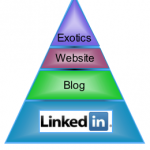Strategy for LinkedIn, Facebook, Twitter: Where Do I Need to Be? shows how to take an ecosystem approach to social networking platforms, so you can use each one for what it does best and create more leverage.
This morning I was interviewed by Canright Communications, a corporate marketing firm, about LinkedIn’s value proposition for executives, and Collin retweeted the “where do I need to be” question, so I’ll offer a thumbnail guide to figuring that out here. Although the chief context remains leaders of companies and agencies, you should find the thoughts broadly applicable to your situation. I also invite inquiries using the comment functionality beneath this post.
Under the Hood
 Before delving into which Web 2.0 spaces you need to invest in, let’s make explicit some key assumptions that busy executives usually make about disruptive technologies:
Before delving into which Web 2.0 spaces you need to invest in, let’s make explicit some key assumptions that busy executives usually make about disruptive technologies:
- The world existed just fine before (Web 2.0 [substitute other disruptive technology name]) arrived; why should I bother learning about it?
- Isn’t this just another overhyped tech time waster?
- I don’t want to spend my valuable time on this; I’ve too much else to do; therefore, which (site) should I invest in?
- Can’t I just delegate this?
As an executive myself, I go through a similar thought process (although I often do it several years before the mainstream market). New technologies do encroach on our time, and they confront us with sorting through how and why we do things. Who likes to sort through their closet or garage for fun?
The easiest way to understand Web 2.0’s opportunities and threats is to remember Web 1.0. In 1994-1997, the Internet was widely touted as a trivial pursuit of overcaffeinated people with too much time on their hands, and the prevailing wisdom was, “No serious organization will use the Internet for business.” Web 2.0 will show that the Internet was a mere overture compared to the disruption it will introduce because it is changing how people relate to each other.
We all filter new innovations, and the older we get, the more we filter. We have more responsibility, and the threat of distraction looms large. We get fouled up when something important passes through the filter when it oughtn’t have. 2009 will be the year of Web 2.0 reckoning for many executives, just as 1999 was the vindication of the Internet.
Guide to Selecting Determining the Relevance of Web 2.0 Sites
 Now, down to business. Here is a back-of-the-envelope treatment of a very sophisticated process that should roughly follow a sequence like this:
Now, down to business. Here is a back-of-the-envelope treatment of a very sophisticated process that should roughly follow a sequence like this:
Analysis phase
- Make explicit who your stakeholders are, and rank them in order of importance to your business goals. Common examples are: clients, investors, the public, analysts and journalists, partners, the government or regulators.
- Determine their adoption of Web 2.0 by learning which venues they spend time in, and what they do there.
- Ask yourself, “How important are the topics, actions and relationships pursued by stakeholders in Web 2.0 venues to us? Are they talking about things we care about? Are they talking about or conversing with other people we care about?”
- You should see trends: people tend to do certain things in certain venues.
- Next, have a look at your organization and your proxies. How do you typically communicate with stakeholders? What is your style and culture? How much of a stretch would it be for your company to interact with people in these venues? Which employees are active already, as individuals?
- Which venues resonate the most with you and with your key stakeholders?
Action phase
- Web 2.0 venues are like restaurants; they each provide a distinct social context around meeting people. Use this to your advantage. Why do you eat in different kinds of restaurants? Based on your goals for meeting with people, you will select the appropriate venue. Although most executives don’t like to hear this, there’s not “one” Web 2.0 venue to spend time in. That said, you can prioritize effectively to make things manageable.
- Let two key things be your guide: follow your stakeholders (“it’s about the people”). And consider what your resources are. Do you have employees or proxies (professional services) who are knowledgeable and motivated?
 Start small and measure results in short cycles.
Start small and measure results in short cycles.- Think about Web 1.0 and think medium/long term. Task an executive with managing your organization’s adoption. You will have to be active with Web 2.0; the questions are how, when and where.
- Make your organization’s investments in different venues by selecting people who: a) know your business and stakeholders and b) are curious about Web 2.0 (and therefore motivated to learn) and c) have some experience with innovations.
- If you keep investment small, you can avoid burdening yourself with strict ROI measures, which have proven elusive thus far.
At a minimum, most companies need to get involved from an R&D perspective; get the right people interacting with meaningful stakeholders; have a process to capture learning about Web 2.0 activity; share in fast cycles with people who matter.
Guiding principles about venues
Although companies and people are different, here is a very brief thumbnail about venue value propositions. To make my perspective explicit, I advise executives of enterprises, entrepreneurs and government in largely a B2B context. The first and third groups are very conservative, and the second group often sells to the others. These are my stakeholders. Most of my clients are in the United States, but I am actively pursuing business in Asia and Latin America.
 The Web 2.0 Pyramid right is a broad generalization that may be valuable for B2B focused executives whose stakeholders are executives and professionals.
The Web 2.0 Pyramid right is a broad generalization that may be valuable for B2B focused executives whose stakeholders are executives and professionals.
- LinkedIn (business focused) is my primary investment in terms of branded sites. The context is business. I find more people I want to do business with in LinkedIn than in any other site. People are in LinkedIn to do business. Think of it as the restaurant with conservative good taste; not racy or terribly entertaining but excellent for business relationships.
- Facebook (R&D focused) is extremely important for different reasons. For many people, it is the current “portal of life.” If LinkedIn is the business section of the newspaper, Facebook is the whole thing. It’s very important to understand emerging trends, technologies and behaviors. Depending on your stakeholders [and the business context around which you want to interact with them] Facebook can be very relevant for business. A large portion of Facebook is created by customers—for free (“Apps”). Many executives, however, find it overwhelming. It also incorporates the concept of real-time status. People increasingly forsake email for Facebook because there’s relatively little spam on Facebook. Many innovative advertising and business opportunities.
- Twitter (microblog, business-focused) is likewise very important from R&D and marketing perspectives. The hardest thing to understand about Twitter and other microblogs like Plurk, Tumblr and Kwippy is how small touches roll up to relationship (but they do). If you want to get to know someone, follow her Twitter feed. Twitter is about the real-time status of you and your stakeholders, and there are myriad business applications. Ask yourself, “What would it mean for some of our business process owners to know what stakeholders are doing?” Twitter enables the latter to self-report. For an example, see the Social Network Roadmap’s Twitter feed.
- Blogs that your stakeholders create or participate in should be a #1 priority. Most are free-flowing thoughts around the context in which your company adds value—or not. People can say what they really think. Blogs will present you with a baffling array of unstructured data, which can be frustrating to a well-oiled marketing machine, but it’s the new reality.
- Podcasting offers another medium for content that can have very relevant business applications. People can listen when they are doing other things. According to NLP, 20% of your stakeholders are auditory people, so you can communicate with them better when they can hear you. One fifth of your stakeholders. For many companies, stakeholders don’t expect podcast availability yet, but I expect this to change during the next 2-4 years.
- Video is an iceberg that will surprise many liners. I predict that video will become the default means of communication over the next ten years. That means that certain demographics of stakeholders will increasingly prefer to watch you, not to read you. Most businesses don’t need big YouTube presences in 2009, but everyone should keep it on his radar screen.
Parting Shots
 The investments you make (“Facebook vs. LinkedIn”) should be based on your stakeholders and their priority to you.
The investments you make (“Facebook vs. LinkedIn”) should be based on your stakeholders and their priority to you.- Don’t only look for activity.. but look at trends. In many industries, Web 2.0 activity is just beginning, so don’t reject it out of hand in January, only to find in June that a surprising number are involved.
- Think small. Most companies should start building resident Web 2.0 expertise, and you can do this by keeping investments modest. This is about your customers and how they make buying decisions. Don’t let someone pull the rug out from under you.
- Watch Obama. His administration will surprise many because Web 2.0 is its O/S. They will change many aspects of government with alacrity, which will drive adoption elsewhere.
- Get the right people involved. The team needs resident knowledge of your business and stakeholders as well as Web 2.0 enthusiasts and people with track records for spearheading innovation in your organization.
- This is a portfolio play, so make several investments. If you get people who want to learn about it, they can do a lot because they are excited to learn more.
- Get stakeholders involved; this often means relatively little cash investment on your part.
- I help companies and agencies do the analysis and action phases described above (as well as others). See About CSRA, The Ecosystem Audit, The Organization Audit, and Using the Social Network Roadmap(SM).

[…] MUST READ—Strategy for LinkedIn, Twitter, Facebook: Where Do I Need to Be? […]
[…] post Strategy for LinkedIn, Facebook, Twitter: Where Do I Need to Be? appeared first on Christopher S. Rollyson and […]